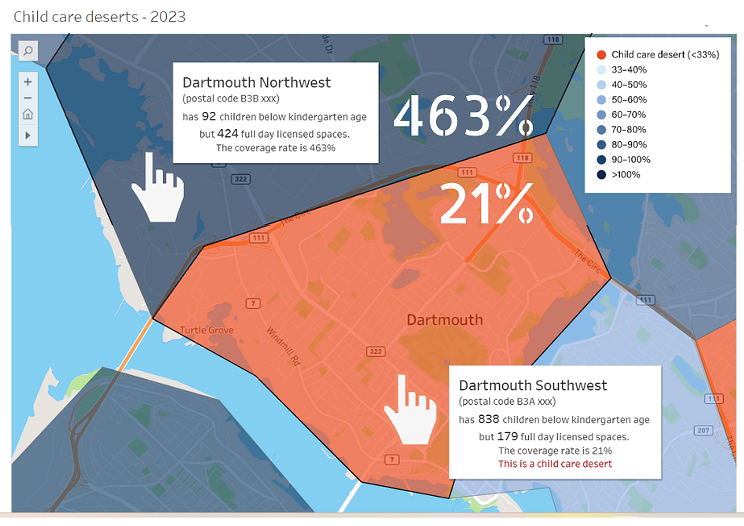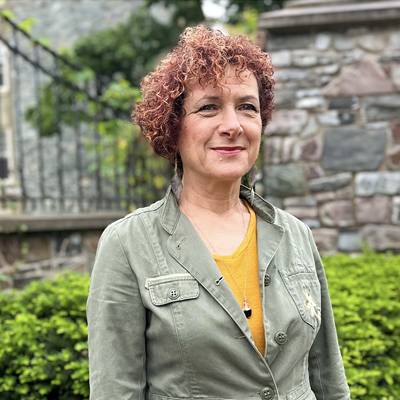Corrections January 31: After this story was published, the province got in touch about two things. First, we were wrong to say the “annual report from 2023 is overdue” because Nova Scotia’s funding agreement with the federal government doesn’t require a publicly available annual report. The province assures us that the required Action Plan was filed to the feds on time. Second, Kenya Thompson was getting ahead of things when she said the province “met that $10 per day target” for what day care should cost; she reached out to The Coast to retract this statement. The province says it’s “on track to reach $10 a day, on average, by 2026,” but isn’t there yet. “We have reduced fees by 50 per cent, on average,” the province emails. “It is also worth noting that some families currently have access to care for less than $10 per day.” We apologize for these errors.
Nova Scotians are struggling to access child care in both rural and urban areas. This is hardly a new problem. However, the province recently announced $11 million dollars in new funding to help. The first program, called the Minor Infrastructure Program, began accepting applications Jan. 2. It's meant to create up to 800 new spots in child care centres that meet certain criteria.
One condition is 'community need': “Applications must be for projects located in Nova Scotia communities with a demonstrated lack of child care to create full-time, infant, toddler, and pre-school spaces, with a priority for projects serving diverse and/or marginalized populations.”
That is, child care deserts should be getting priority.
In a 2018 report, study author and senior economist with the Canadian Centre for Policy Alternatives–CCPA–employed the term ‘child care deserts’ to refer to postal codes across Canada where there are at least three children potentially competing for a single licensed child care space–or 33% child care coverage and under.
In May 2023, the CCPA– released an updated report on ‘child care deserts’ across Canada. Based on 2021 census data, Nova Scotia had 47% of young children under 4 living in child care deserts. In the HRM, that number is 35%. An interactive map of child care deserts across Canada which was linked in the 2023 report can be found here.
As the province continues to roll out its five-year Canada Nova Scotia Canada-Wide Early Learning Child Care Agreement, they’ve committed to reducing child care fees to $10, creating 9,500 new early learning and child care spaces, improving before-and-after school programs and increasing wages and benefits for early childhood educators–ECEs–by 2026.
They’ve also committed to increasing the provincial child care coverage to 59%. Since the agreement was signed, fees have reduced by over 50%. But in areas where 1 in 3 children have access to care, is fee reduction a helpful target?
Kenya Thompson is the co-ordinator of Child Care Now | NS which advocates for publicly-funded, comprehensive and accessible non-profit child care.
"Now, many families are experiencing the benefits of that. But too many aren't and are facing big waitlists and, what’s worse, waitlist fees."
Thompson says the Canada-Nova Scotia Canada-Wide Early Learning Child Care Agreement might not be sufficient for meeting and monitoring families' child care needs because, for starters, there are holes in the reported data–when it's reported. The annual report from 2023 is overdue from October as per the agreement's conditions.
“We're not really getting clear numbers on the spaces being created," says Thompson. "Every space is not created equally. There's infant spaces, preschool spaces, school aged wraparound care spaces, there are so many different kinds of spaces and we need all of those.
"But if you’re a family in need of a space for an eight year old, an infant space isn't gonna cut it.”
Infant spaces have been especially hard to come by in Nova Scotia, as noted by CCPA-NS director Christine Saulnier in an article in the Halifax Examiner in May 2023 who likened finding infant child care to a 'treasure hunt.'
However, the province says dis-aggregated data on age-specific space creation is forthcoming.
"We report our progress on space creation quarterly on our dashboard. The Department also submits progress reports as per the Agreement. Timelines for posting the Accountability Report are at the discretion of the federal government.”
Because of a lack of the appropriate type of space, even within areas that aren't child care deserts, families are often left to find their own solutions to child care.
"Folks in childcare deserts rely on patchwork solutions to meet their child care needs," says Thompson.
"For my master's work I interviewed folks in rural areas and a few people in Dartmouth too and I was amazed at the complicated schedules these people had: ‘Okay, I'm dropping my kids off at school, their aunt is picking them up and taking them to my grandmother’s who's gonna bring them home before I get off work at this time and I’m supposed to come in here.’
"These really convoluted schedules that they are forced to rely on are often based on the support of families and unregulated options."We know the benefits of childcare. We need investments to realize a strong system to do it right.”
tweet this
"We know the benefits of high quality early childhood education, such as economic benefits for families–particularly for for women. But it can become a further complication when childcare is not easily accessible to them.”
Thompson says a more “robust” data collection system by the province will account for how many children are on waitlists for spaces in each area, how close by these spaces are to where families live and therefore how short or long travel time is, how flexible these kinds of care are to account for different work schedules, whether spaces are culturally and linguistically diverse and more.
As well, Thompson says the goal of 59% coverage outlined in the Canada-Nova Scotia Agreement isn't sufficient.
“That's not all the families that might need it,” says Thompson. “That's a pretty low target. The main concern that exists within the Nova Scotia agreement specifically is certainly a lack of spaces. That's the biggest problem.
"And when we think about moving forward with the childcare program, families need to experience the positive effects of having access to childcare so that it becomes and remains politically viable in the years ahead.”
An EECD spokesperson says they're now in the final stages of rolling out the Family Home Start Up Program and expects it will be available to new providers this winter. More information about the program and funds available should be coming later this month on the province’s child care website.
Both this and the Minor Infrastructure Program are fully funded through the Canada-Nova Scotia Canada-Wide Early Learning and Child Care Agreement.
The spokesperson with the department says multiple funding programs beyond large construction projects were always a part of their plan to meet the agreement's commitments, and that "the two newly announced programs were developed in the fall and are now being rolled out to diversify opportunities for space creation. We continue to explore new opportunities based on the needs of the sector and space creation progress."
Thompson says more funding is necessary, but it's a big help.
“There's huge investments needed in childcare," says Thompson. "It's excellent that this [agreement and new funding] is coming. These kind of transformative systems need substantial investment to ensure they're successful. And we know we need to give this a good shot.













